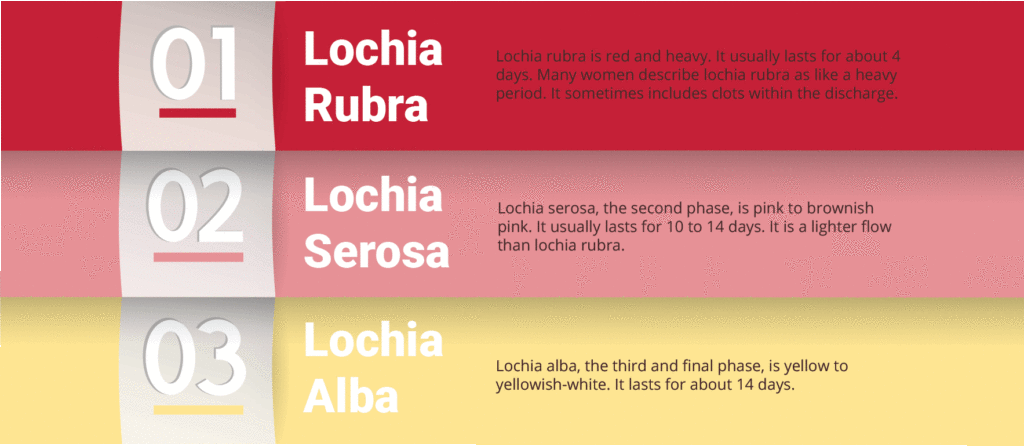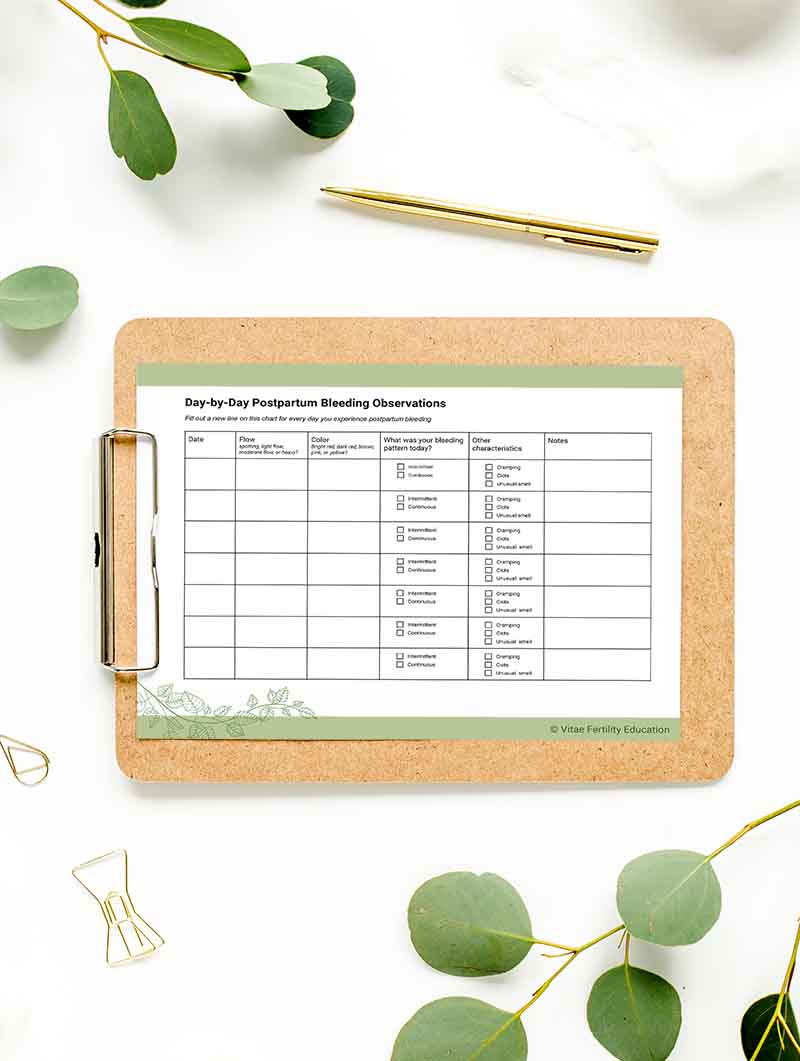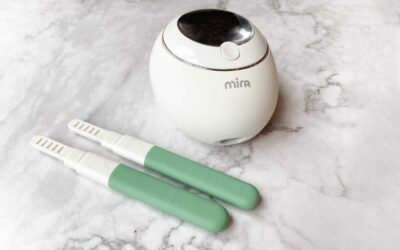You’ve got a new baby in your house. Congratulations!
Maybe you’re snuggling a newborn, or maybe your baby is on the move and you’re chasing a crawler.
But then, seemingly out of nowhere, you’re bleeding again. What’s up?
You may be feeling confused and wondering what your body is trying to tell you. You may be surprised and a little caught off guard if you are experiencing postpartum bleeding you didn’t expect.
To many women, unexpected postpartum bleeding poses something of a million-dollar question. Is this your first postpartum period? Are you fertile again?
If you’re trying to conceive, there’s nothing more exciting than the return of your fertility. The wait is over. You might be able to add another little one to your family soon.
But if you were planning on spacing out your pregnancies a little longer, the question of — “is this my period or not?” — takes on more weight…
… especially if you use natural methods of pregnancy avoidance, like the Marquette Method of NFP (the high-tech method of Natural Family Planning (NFP) we teach at Vitae Fertility).
It’s important to correctly determine if postpartum bleeding is a period or not if you’re using NFP and trying to avoid pregnancy.
If you don’t get it right…
- if you think it’s a period, but it’s not or
- if you think it’s not a period, but it actually is
… it could result in a lot of unnecessary abstinence, or even an unexpected pregnancy.
In this post, I’ll start by going over the common types of postpartum bleeding—lochia, “healing bleeds,” hormonal bleeds/estrogen breakthrough bleeds, and periods.
At the end of the post, I’ll walk you through how to take notes on your bleeding experience and give you a set of questions to answer. The information you collect will help you and your NFP instructor determine the cause of the bleeding.
From there you can decide whether the bleeding you’re experiencing is a period or not … so that you can plan accordingly, confident that you’re following the right set of NFP instructions for your stage of fertility.
Table of Contents
Types of Postpartum Bleeding
Lochia (Lochia Rubra, Lochia Serosa, Lochia Alba)
Usually lasts 3 to 6 weeks
The bleeding you experience immediately after delivery is called lochia. Lochia typically lasts for 3-6 weeks postpartum, and transitions through 3 phases.
Lochia rubra, the first phase, is red and heavy. It usually lasts for about 4 days. Many women describe lochia rubra as like a heavy period. It sometimes includes clots within the discharge.
Lochia serosa, the second phase, is pink to brownish pink. It usually lasts for 10 to 14 days. It is a lighter flow than lochia rubra.
Lochia alba, the third and final phase, is yellow to yellowish-white. It lasts for about 14 days.

The time it takes to progress through the three stages of lochia, and how long these phases last (and their characteristics) can vary. Changes in your activity and stress levels can change your lochia discharge.
If your bleeding following delivery does not seem to follow this progression—or if you’re ever concerned about the amount of bleeding that you are having— get in touch with your healthcare provider. One life-threatening concern during this time is postpartum hemorrhage (PPH) which can occur anywhere from right after delivery until 12 weeks postpartum.
Signs of PPH can include a sudden increase in your bleeding, needing to change your pad more than every hour, having large clots, signs of fever, lightheadedness, or dizziness.
Delivering a baby is a beautiful and natural process, but it can also pose quite a bit of trauma. Be on the watch for anything that seems unusual and reach out to your healthcare provider promptly with any concerns that you have.
Lochia is a normal part of the postpartum healing process. It’s not a sign of your fertility returning. (There’s no need to fill out a postpartum bleeding chart for lochia—we’ll talk about this a bit more later.)
Bleeding that occurs after lochia has stopped, however, can be a sign of your return to fertility. If that’s the situation you’re in now, keep reading.
Are You Breastfeeding?
For most women, breastfeeding delays the return to fertility. Fertility returns relatively quickly, however, in non-breastfeeding women—the average time to ovulation in non-breastfeeding women is 45-94 days postpartum (Jackson & Glasier, 2011).
If you aren’t breastfeeding and are experiencing new bleeding it’s likely an indication that your fertility is returning.
If you are breastfeeding then there are several factors to consider to help identify whether this bleeding could be a period. Read on.
A “Healing Bleed”
Usually occurs between 6 and 8 weeks postpartum
The site where the placenta was attached to the uterus is large (about the size of a dinner plate). When it heals, a scab forms on the uterus. As you become more active, it’s common for this scab to break loose. This can cause some light bleeding or spotting. This generally lasts for a couple of days before stopping.
Bleeding from this scab breaking loose—often called the “healing bleed”—is quite common. One study showed that nearly 50% of women experience a healing bleed, usually around 6 to 8 weeks after the birth of their child. If you’re breastfeeding, it’s unlikely that bleeding you might experience in this timeframe—between 6 and 8 weeks postpartum— represents a return to fertility (Visness et al., 1997).
If the bleeding you’re experiencing is soon after your lochia has stopped, think about whether you’ve recently increased your activity levels, because that’s another possible cause.
Your body is amazing, it gives lots of feedback! Bleeding after an increase in activity is one way your body reminds you that you are still healing, gently telling you to slow down a bit so you can fully recover.
Hormonal Bleeds
(also known as estrogen withdrawal bleeding or breakthrough bleeding)
Can occur anytime postpartum
Breakthrough bleeding, also called hormonal bleeding, is a type of postpartum bleeding which can occur well after the birth of your baby. The hormones of postpartum, breastfeeding women tend to ebb and flow. It’s possible for estrogen to rise and then lower again on its own—this isn’t always related to an egg developing, sometimes it’s just related to breastfeeding!
In regular cycles, rising estrogen causes the endometrial lining of the uterus to build up and thicken—and then progesterone (which rises after ovulation) supports this endometrial lining and causes it to stop thickening.
Breastfeeding, postpartum women can have estrogen levels which remain high for longer (more days) than in a normal cycle. However, without progesterone to support and sustain the endometrial lining, some bleeding can occur as the endometrium sloughs off a bit.
If you’re using the Marquette Method, you may notice that these bleeds correlate with getting more high readings on the monitor (which means elevated estrogen). If you’re using a mucus-based method of NFP, you may notice an increase in cervical mucus (also a sign of elevated estrogen levels.)
Postpartum Period
Not all bleeding is considered a period. By definition a period is shedding of the endometrial lining that occurs after ovulation. Your first postpartum period might not present the same way that your periods did prior to pregnancy—some women’s first postpartum period is a relatively light bleed compared to what is normal for them, and some have a very very heavy bleed. It all depends on how thick the endometrial lining was and how healthy the follicle was after ovulation.
Because the first postpartum period might not act the same as a ‘typical’ period for you, tracking the quality and quantity of bleeding is very important—it’ll help to determine whether the bleed you’re experiencing is truly a period, or not.
Tracking Postpartum Bleeding
If you’re experiencing postpartum bleeding, and aren’t sure what it may be related to, a great place to start is to collect day-by-day data about your experience.
- How heavy was your bleeding? Was it spotting, light flow, moderate flow, or heavy flow?
- What was the color of your bleeding? Was it bright red, dark red, brown, pink, or yellow?
- Was it intermittent (on and off during the day) or continuous?
- Did it smell like your normal period bleed?
- Did you have cramping?
- Were there clots?
Having a clear record of your day-to-day bleeding experience provides much of what we, as NFP instructors, need to know to help you determine if your bleeding is a period or not. Of course, keep tracking and charting your other fertility signs, too, as per the NFP protocols you’re following (like mucus observations or fertility monitor readings.)
Other information that provides clues as to what’s going on with your body are answers to the following questions:
- How many weeks old is your baby?
- Are you breastfeeding? If yes, how much are you breastfeeding? Have you or your baby changed your breastfeeding habits recently? (For example, are you breastfeeding more than before? Breastfeeding less than before? Supplementing with formula? Introducing solids? Night weaning? Have you recently started or stopped pumping?)
- Have you been more active than normal or engaged in any strenuous activities lately?
- Are you experiencing an unusual-for-you level of stress?
- Are you (or did you) have any period symptoms (breakouts, headaches, cramps, etc.) before or during this postpartum bleed?
- What were your periods like prior to this new little one’s arrival? How heavy were they, and how long did they last? Is this episode of postpartum bleeding similar to your periods before having your baby, or is it different?
- Finally, does it feel like a period to you? Does it look and act like periods you’ve had before?
To keep track of your day-to-day observations and your answers to these questions, download and fill out this postpartum bleeding chart.

Download the Printable Postpartum Bleeding Chart (PDF)
So — back to the million-dollar question.
Is this your first postpartum period?
Research has shown that about two-thirds of women ovulate prior to their first postpartum period (Campbell & Gray, 1993).
If you are tracking with Marquette or another method of NFP and detect ovulation prior to your bleeding episode, you can be fairly certain that the bleeding you are experiencing is a period.
It’s the other one-third of women—the women who have bleeding which isn’t preceded by ovulation—that are harder to determine. In these cases your NFP instructor will find a detailed record of your bleeding episode incredibly helpful in discerning the best steps forward—which is why we urge women to chart bleeding episodes so carefully.
Bleeding and the LAM Method
If you’re using the Lactational Amenorrhea Method (LAM) to prevent pregnancy for the first 6 months of your baby’s life, any bleeding which occurs after 56 days postpartum disqualifies you for LAM, even if it’s just one instance of spotting. If this is your situation, it’s time to start abstaining and switch to tracking your fertility with NFP for the remainder of your postpartum transition if you want to continue avoiding pregnancy.
If you don’t have an NFP instructor, and you’re not sure what to do about the bleeding you’re experiencing, we offer free consultations and would be glad to answer your questions, anytime. The Marquette Method of NFP is particularly popular among postpartum, breastfeeding women because it’s easy to use, easy to learn, and highly effective.
And, if your cycles haven’t returned, you could be up-and-running with Marquette’s breastfeeding protocols within 48 hours of meeting with your instructor (unlike other methods of NFP, there’s no need to abstain while you learn the ropes.)
Our goal is to help you get clarity on your fertile status so you can track with confidence, letting you get back to more important things. Like loving on your sweet little one.
References
Campbell, O. M., & Gray, R. H. (1993). Characteristics and determinants of postpartum ovarian function in women in the United States. American journal of obstetrics and gynecology, 169(1), 55–60. https://doi.org/10.1016/0002-9378(93)90131-2
Jackson, E., & Glasier, A. (2011). Return of ovulation and menses in postpartum nonlactating women: a systematic review. Obstetrics and gynecology, 117(3), 657–662. https://doi.org/10.1097/AOG.0b013e31820ce18c
Visness, C. M., Kennedy, K. I., Gross, B. A., Parenteau-Carreau, S., Flynn, A. M., & Brown, J. B. (1997). Fertility of fully breast-feeding women in the early postpartum period. Obstetrics and gynecology, 89(2), 164–167. https://doi.org/10.1016/S0029-7844(96)00483-8





